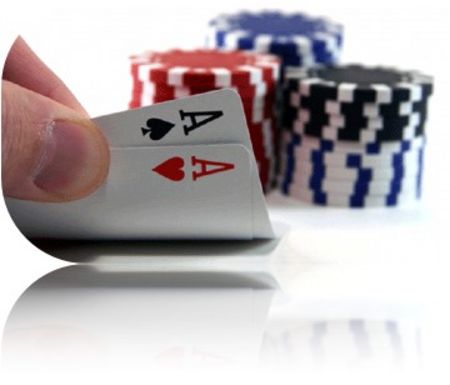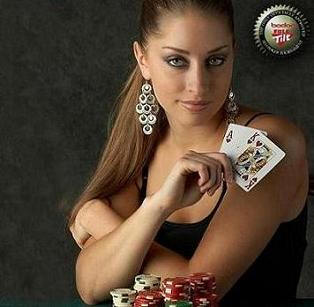Betting Strategies

After evaluating the relative strength of your hand given the type of flop and
possible hands of your opponents, you then need to determine the best betting
strategy on how to play your hand. These possibilities include all the basic poker
concepts we discussed in the beginning of the book: bluffing, semi-bluffing, raising,
check-raising, calling, slowplaying, buying a free card, betting, and finally folding.
Let's review the various strategies you can employ:
- Betting out with the best hand. Normally you should come out betting | when
you feel you have the best hand, One exception to this is when you want to
check-raise the best hand or to also drive out opponents. Do not be afraid of
betting into a preflop raiser.
- Betting out to protect your hand. Sometimes you may not be sure your hand
is best, but you have to bet out to protect your hand against a free card in
case you have the best hand.
- Betting out to see where you are in the hand. Sometimes a correct strategy
is to bet out to see what happens behind you. if you are raised you can then
consider folding if you have a medium holding, If couple of players just call,
you might need to back off on the turn if your hand is not too strong. Betting
to gain information can save you bets if it allows you to gel out of the hand
early, rather than checking and calling all the way down to the river.
- Betting a bluff or semi-bluff. Against one or two opponents (and rarely with
three), sometimes you can bet out as a bluff or semi-bluff.
- Calling / Checking and calling as a slowplay. Simply calling to slow-play a
really strong hand is a good strategy sometimes with a small pot, Checking
and calling is also a good strategy against aggressive opponents to induce
them to bluff on the flop and turn.
- Calling / Checking and calling mediocre hands. When you have a medium
holding, sometimes it is correct to just call to see how the hand develops.
This is also correct when there are many dangerous cards that could hurt
your hand. Rather than committing a lot of chips to the pot, you wait and see
if the turn card is favorable.
- When you are on a draw, checking and calling is the correct strategy when:
1.You do not think you could win with a semi-bluff.
2.You do not want to drive out other opponents either by betting or raising,or by betting and risking a raise directly behind you.
3.There are not enough opponents to justify a check-raise (see below).
- Check-raising. When you feel you have the best hand, you might check-raise
to gain additional bets. You might also check-raise with the goal of driving
out other players from the pot. You might check-raise your strong draws if
there are a sufficient number of players in the pot to justify the pot odds.
Finally, you can try a check-raise bluff or semi-bluff if you feel the bettor is
bluffing and you want to try to win the pot immediately or set up a semi-bluff
bet on the turn.
- Raising with the best hand. When you feel you have the best hand and
someone bets into you, you should almost always raise. The exception is
when you want to slowplay your hand and wail to raise on the turn or river.
Raising to protect your hand. If your hand is vulnerable and you are not sure
if you have the best hand, you still may need to raise to protect your hand
against the remaining opponents acting behind you.
- Raising to try for a free card. You can raise with your draw to try for a free
card on the turn. When you have a hand that you are unsure is the best
hand, you can also raise with the intention of checking the turn. In this case,
you are minimizing your losses when an opponent has a better hand, while
allowing you to play out the hand to the river.
- Raising as a bluff or semi-bluff. You might raise with the hopes of winning the
pot immediately.
- Checking. Sometimes you find yourself in late or last position where
checking would take the hand to the turn. In general you should almost
always bet a strong hand, although there may be circumstances when you
might check the flop and wait to see if the turn card is favorable. Checking
your medium holdings is sometimes correct if betting is unlikely to drive out
many opponents when the pot is large, or if you are at risk of being cheek-
raised and you want to see the turn card cheaply.
- Folding. Folding is correct under the fallowing circumstances:
You are not getting good implied pot odds that you have the best hand.
You are not getting sufficient odds to draw.
You are not getting sufficient odds to try a bluff or semi-bluff.
There is one exception. Sometimes you might fold even when you have the
best hand on the flop, This occurs when the flop is so dangerous that it is
doubtful that your hand could win on the river. For example, a medium pair
against many callers on the flop is a dangerous situation. Even a relatively
high pair is risky when there are many overcards, flushes, and straight draws
that could beat you. For example, you might fold T ♥ 5 ♦ against several
opponents with a flop of T ♣ 9 ♣ 8 ♠.
The flop is a defining moment in Texas Hold'em. Evaluate the relative
strength of your hand given the type of flop and the possible hands of your
opponents before deciding a betting strategy. The following chapters will look
at the considerations and strategies for each type of hand in more detail.
Review

The flop is a defining moment in Texas Hold'em. It is important to determine right
away if your hand has value before you start committing chips to the pot.
It is often the mistakes you make on the flop that create further mistakes on the turn
and river.
The most important considerations you should evaluate with each flop include:
-
The strength of your hand
- The type of flop
- Number of opponents
- Possible hands of opponents
- The pot size
- Cost/Potential cost of bet
The main types of flops are as follows:
- Three of a Kind
- High Pair
- Low Pair
- Two-Suited
- Three-Suited
- Two-Connected
- Three-Connected
- All High Cards
- Rainbow with One High Card
- Rainbow of All Rags
Various strategies on the flop include the following:
- Betting out with the best hand
- Betting out to protect your hand
- Betting out to see where you are in the hand
- Betting a bluff or semi-bluff
- Calling / Checking and calling as a slowplay
- Calling / Checking and calling mediocre hands
- Check-raising
- Raising with the best hand
- Raising to protect your hand
- Raising to try for a free card
- Raising as a bluff or semi-bluff
- Checking
- Folding
Always evaluate the relative strength of your hand given the type of flop and the
possible hands of your opponents before deciding a betting strategy.
NEXT...Nut Hands

